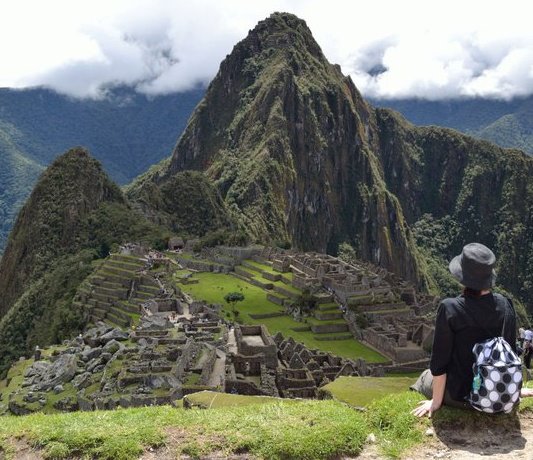
Day Trip- Tour of the D-Day Beaches
Normandy Region, France
April 5, 2012
 We wanted to honor the memory of our grandfather and pay
our respects to all that bravely faced battle on D-Day. Our Grampy was one of the many heroic troops
that stormed the beaches of Normandy on June 6, 1944. Part of the Army Infantry, he waded out of
the English Channel and advanced onto the shore of Omaha Beach. German troops stationed on the cliffs above
the beach showered them with heavy gunfire.
My grandfather was told ‘You will see people fall on the left and right
of you- just keep running forward.’ And that is what my Grampy did until he was
hit in the head and leg. He spent months
in a hospital rehabilitating from his wounds.
We wanted to honor the memory of our grandfather and pay
our respects to all that bravely faced battle on D-Day. Our Grampy was one of the many heroic troops
that stormed the beaches of Normandy on June 6, 1944. Part of the Army Infantry, he waded out of
the English Channel and advanced onto the shore of Omaha Beach. German troops stationed on the cliffs above
the beach showered them with heavy gunfire.
My grandfather was told ‘You will see people fall on the left and right
of you- just keep running forward.’ And that is what my Grampy did until he was
hit in the head and leg. He spent months
in a hospital rehabilitating from his wounds.
 After researching the benefits of a tour guide vs. a
self-guided tour of the area, we decided that €60/pp for a knowledgeable guide and
driver was a pretty good deal. We booked
online with Normandy Sightseeing Tours and purchased train tickets from Paris
to Bayeux and back for a day in the Normandy Region of France. The views of the French countryside were idyllic. Sheep dotted rolling hills, huge old
cathedrals stood in the middle of tiny walled villages. It was all as quaint as it could possibly be.
Our destination of Bayeux was equally picturesque and I wish we’d had more time
to explore the town and surrounding area.
After getting off the train, we set off walking in the general direction
of the town square, seeking out Place du Quebec, a small square behind the Churchill
Hotel, our rendezvous spot. We picnicked
beside a stream while waiting for our guide.
After researching the benefits of a tour guide vs. a
self-guided tour of the area, we decided that €60/pp for a knowledgeable guide and
driver was a pretty good deal. We booked
online with Normandy Sightseeing Tours and purchased train tickets from Paris
to Bayeux and back for a day in the Normandy Region of France. The views of the French countryside were idyllic. Sheep dotted rolling hills, huge old
cathedrals stood in the middle of tiny walled villages. It was all as quaint as it could possibly be.
Our destination of Bayeux was equally picturesque and I wish we’d had more time
to explore the town and surrounding area.
After getting off the train, we set off walking in the general direction
of the town square, seeking out Place du Quebec, a small square behind the Churchill
Hotel, our rendezvous spot. We picnicked
beside a stream while waiting for our guide.
 When Sylvain "Sly" pulled up, I turned to Jo
and said ‘I hope he’s our guide!’ I’ll
just go ahead and say it- he’s fairly dreamy.
I mean, he’s got this French accent and a dry sense of humor and he
looks nice. But on top of that he’s very
knowledgeable about the history of the region and has the ability to explain
military strategy and situations in a way that was insightful and thought-provoking.
He added so many details to the story
that the history books don’t include and gave us a new perspective on what went
down.
When Sylvain "Sly" pulled up, I turned to Jo
and said ‘I hope he’s our guide!’ I’ll
just go ahead and say it- he’s fairly dreamy.
I mean, he’s got this French accent and a dry sense of humor and he
looks nice. But on top of that he’s very
knowledgeable about the history of the region and has the ability to explain
military strategy and situations in a way that was insightful and thought-provoking.
He added so many details to the story
that the history books don’t include and gave us a new perspective on what went
down. Sylvain said that we could take the highway directly to our first official tour destination but he preferred to take back roads so that his guests could see Normandy. I am thrilled that he did- the area is just breathtaking! We passed a thousand-year-old church, a farm that produces award-winning apple brandy, a monument to a battle between the French and English hundreds of years ago. I decided that I want to return and tour the area by bicycle- there are just so many magnificent views to take in.
We arrived at our first stop- Pointe du Hoc, 100-foot cliffs where the Germans had stationed 6 heavy guns capable of shooting targets miles away. Army Rangers succeeded in disabling the guns but misinformation and lack of communication made the mission a very difficult one with very heavy losses. As Sylvain told us, the small craters that pocked the area were made by the Air Force attacking from the sky and the big pits were the result of the Navy bombarding from sea. Looking down on the beach from the top of the cliffs, it was easy to recognize how difficult it would have been to scale those walls and accomplish the objective.
 Our next stop was Omaha Beach, the beach my grandfather
stormed almost 70 years before. We
walked toward the shore and stood facing inland, looking at the hills and
cliffs above. We were all overcome with
emotion over the sacrifice our grandfather made on that beach. The weather was bleak that day, much as it
was on D-Day. There were high winds and sporadic
rain and it was really cold but it added to our understanding of what the
troops went through. We collected vials
of sand and sea shells, paid remembrance to our grandfather, grouped hugged and
walked to the van.
Our next stop was Omaha Beach, the beach my grandfather
stormed almost 70 years before. We
walked toward the shore and stood facing inland, looking at the hills and
cliffs above. We were all overcome with
emotion over the sacrifice our grandfather made on that beach. The weather was bleak that day, much as it
was on D-Day. There were high winds and sporadic
rain and it was really cold but it added to our understanding of what the
troops went through. We collected vials
of sand and sea shells, paid remembrance to our grandfather, grouped hugged and
walked to the van.
 As we walked into the American Cemetery, we encountered a
group of boisterous teens on a school trip.
As they were laughing and hamming it up for pictures, Sylvain approached
them, explained that this cemetery deserved respect and reverence and asked
them to behave more appropriately. He
then continued with his tour. Sly said
that we could take some time to walk around the cemetery, go to the Visitor’s
Center or observe the flag ceremony. They asked for Americans to participate in
taking down and folding the flag and Joanna volunteered. As she helped lower the flag, a bugler
sounded ‘Taps’. We were all moved to
tears.
As we walked into the American Cemetery, we encountered a
group of boisterous teens on a school trip.
As they were laughing and hamming it up for pictures, Sylvain approached
them, explained that this cemetery deserved respect and reverence and asked
them to behave more appropriately. He
then continued with his tour. Sly said
that we could take some time to walk around the cemetery, go to the Visitor’s
Center or observe the flag ceremony. They asked for Americans to participate in
taking down and folding the flag and Joanna volunteered. As she helped lower the flag, a bugler
sounded ‘Taps’. We were all moved to
tears. The last destination on our tour was Longues-sur-Mer, another German battery. Still displayed in the bunkers are the actual four guns with a range of 15 miles, enough to defend Omaha and Gold Beaches. But the Allied Forces were able to destroy them and the evidence of the damage inflicted can be observed in those bunkers.
By the end of the tour, we were cold, hungry and tired. But the daytrip to the Normandy Region and our tour of the D-Day Beaches were outstanding and sharing the experience with my sisters made it even more special. We were able to pay homage to a man that was very special to us and gain some understanding of the life experiences that shaped him. Touring the D-Day Beaches was the most moving experience of our entire trip.
D-Day Photograph- "Taxis to Hell – and Back – Into the Jaws of Death" is a historic photograph taken on June 6, 1944, by Robert F. Sargent, a Chief Photographer's Mate in the United States Coast Guard. Public domain; official U.S. Coast Guard photograph.








No comments:
Post a Comment